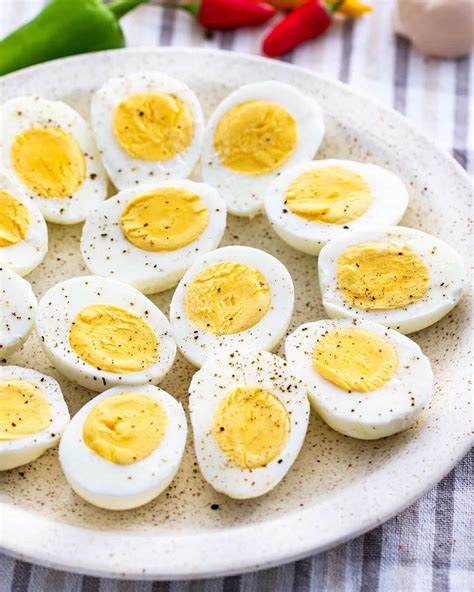Hard-Boiled Egg Recipes: The Ultimate Guide to Perfectly Cooked Eggs
Are you tired of rubbery, overcooked, or that dreaded green ring around your hard-boiled eggs? This comprehensive guide will walk you through various methods to achieve perfectly cooked hard-boiled eggs every single time. We'll cover everything from cooking techniques to storage tips, ensuring your hard-boiled eggs are delicious and ready whenever you need them.
Mastering the Art of Hard-Boiling Eggs: Different Methods for Perfect Results
There's more than one way to skin a cat (or boil an egg!), and the method you choose might depend on your equipment and preferences. Here are a few popular techniques:
Method 1: The Stovetop Method (Classic & Reliable)
This is the most common method and arguably the easiest. It requires only a pot, water, and your eggs.
Ingredients:
- Eggs
- Water
Instructions:
- Place eggs gently in a single layer in a saucepan. Avoid overcrowding the pan.
- Cover the eggs with cold water by about an inch.
- Bring the water to a rolling boil over high heat.
- Once boiling, immediately remove the pan from the heat, cover, and let the eggs sit in the hot water for 10-12 minutes for perfectly hard-boiled eggs. Adjust timing slightly depending on the size of your eggs. Larger eggs may require an extra minute or two.
- Transfer the eggs to a bowl of ice water to stop the cooking process immediately. This prevents the yolks from turning green.
- Peel under cold running water for easiest peeling.
Method 2: The Instant Pot Method (Fastest & Easiest)
For those who own an Instant Pot, this method offers speed and convenience.
Ingredients:
- Eggs
- Water
Instructions:
- Place a trivet in the Instant Pot.
- Add 1 cup of water to the bottom of the Instant Pot.
- Carefully place the eggs on the trivet. Avoid overcrowding.
- Close the lid and set the valve to sealing.
- Cook on high pressure for 5 minutes.
- Allow for a natural pressure release for 10 minutes. Then, carefully quick release any remaining pressure.
- Immediately transfer the eggs to an ice bath.
- Peel under cold running water.
Method 3: The Steamer Method (for a more delicate egg white)
This method produces eggs with a slightly more tender white.
Ingredients:
- Eggs
- Water
Instructions:
- Fill a steamer basket with enough water to reach the bottom of the steamer.
- Place the eggs in the steamer basket.
- Steam for 12-15 minutes.
- Immediately transfer to an ice bath.
- Peel under cold running water.
Tips for Perfect Peeling Every Time
Peeling hard-boiled eggs can be frustrating! Here are some tips to make the process smoother:
- Use older eggs: Older eggs peel more easily than fresh ones.
- Start with cold eggs: Avoid peeling them immediately after cooking. Let them cool down completely.
- Add baking soda to the water: Adding a teaspoon of baking soda to the water while boiling can help with peeling.
- Tap the egg all over before peeling: This creates tiny cracks, which makes peeling much easier.
Beyond the Basics: Delicious Hard-Boiled Egg Recipes
Hard-boiled eggs are incredibly versatile. They're a great snack on their own, but they also feature prominently in many dishes.
- Deviled Eggs: A classic appetizer, deviled eggs are easy to make and always a crowd-pleaser.
- Egg Salad Sandwiches: A simple and satisfying lunch option.
- Breakfast Bowls: Hard-boiled eggs add protein and texture to your breakfast bowls.
- Salads: Chopped hard-boiled eggs can add a boost of protein and flavor to your salads.
Storage and Shelf Life
Proper storage is key to maintaining the freshness and quality of your hard-boiled eggs.
- Refrigerate: Store peeled or unpeeled hard-boiled eggs in an airtight container in the refrigerator.
- Consume within a week: For optimal quality, consume hard-boiled eggs within a week of cooking.
By following these tips and techniques, you'll be well on your way to mastering the art of hard-boiled eggs and creating delicious meals and snacks. Happy cooking!
